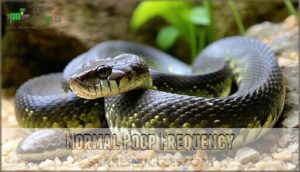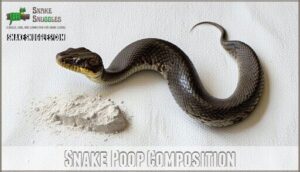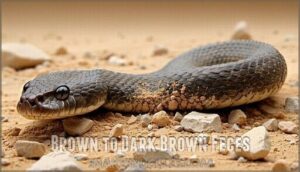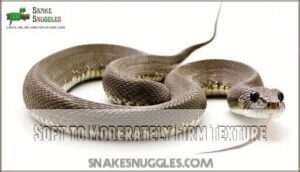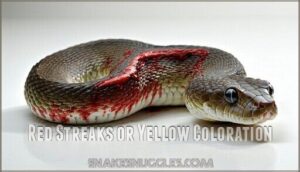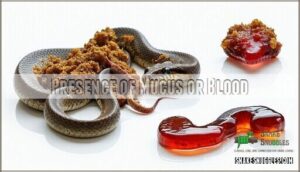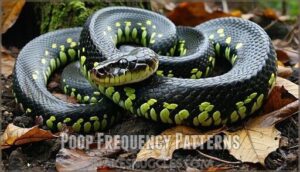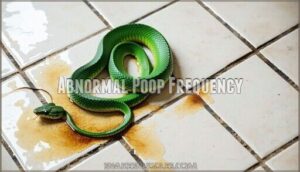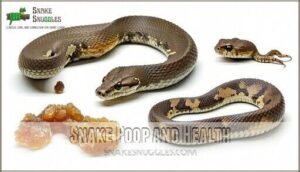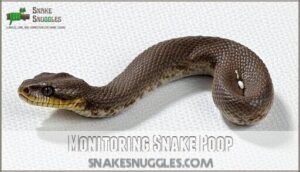This site is supported by our readers. We may earn a commission, at no cost to you, if you purchase through links.
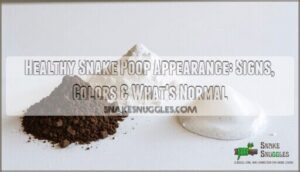
You’ll notice the texture is firm but not rock-hard, similar to Play-Doh consistency. The feces shouldn’t contain visible undigested food pieces, and there shouldn’t be any red streaks, yellow coloring, or strong odors.
Your snake’s waste might look alarming if you’re new to reptile ownership, but this tri-colored combination is perfectly normal. The white chalky portion often confuses beginners who mistake it for something concerning.
Understanding these normal characteristics helps you spot potential health issues before they become serious problems, and recognizing what is perfectly normal can alleviate unnecessary concern, allowing you to focus on maintaining your snake’s overall well-being.
Table Of Contents
- Key Takeaways
- Healthy Snake Poop
- Normal Poop Frequency
- Snake Poop Composition
- Poop Color and Consistency
- Snake Digestion Process
- Unhealthy Poop Signs
- Poop Frequency Patterns
- Abnormal Poop Frequency
- Snake Poop and Health
- Monitoring Snake Poop
- Frequently Asked Questions (FAQs)
- What does an unhealthy snake poop look like?
- When should I worry about snake poop?
- What color is healthy snake poop?
- How often should I clean snake poop?
- Can snake poop spread diseases to humans?
- What causes snake poop to smell bad?
- Do different snake species have different poop?
- Should I handle snake poop with gloves?
- Conclusion
Key Takeaways
- You’ll recognize healthy snake poop by its two distinct parts: dark brown to black feces and chalky white urates, with a firm but not rock-hard texture similar to Play-Doh consistency.
- Your snake’s bathroom schedule follows its feeding pattern – expect waste every 5-14 days depending on meal frequency, with younger snakes eliminating more often than adults.
- Watch for warning signs like red streaks, yellow coloration, runny consistency, strong odors, or excessive mucus, as these indicate potential health problems requiring veterinary attention.
- You should monitor your snake’s waste regularly and keep a simple log of frequency and appearance to catch digestive issues, infections, or parasites before they become serious problems.
Healthy Snake Poop
You’ll recognize healthy snake poop by its two distinct parts: brown or black feces paired with white chalky urates.
Healthy snake waste shows two clear parts: dark feces and white chalky crystals working together.
This normal waste should feel firm but not hard, with a mild earthy smell and clear separation between the dark fecal matter and white urine crystals.
Brown Feces and White Urates
Healthy snake poop consistently shows two distinct parts: brown or black feces and white chalky urates.
The snake feces appearance reflects efficient carnivorous digestion, while snake urate color indicates proper kidney function.
Melanin influence from prey creates darker coloration.
- Feces consistency: Brown to dark brown, firm log-shaped waste
- Urates composition: White, chalky crystallized urine segments
- Prey remnants: Hair, scales, or bones may appear naturally
- Healthy mucus: Small amounts provide normal lubrication
- Snake poop color: Dark feces with distinct white urate separation
Firm but Not Hard Texture
Once you spot the classic brown feces and white urates, pay attention to snake poop consistency.
The poop should be firm but not rock hard—think of a cooked sausage, not a dried stick.
This texture hints at proper hydration levels, good prey digestion, balanced fiber content, and a healthy gut microbiome.
Overly hard or crumbly waste may signal dehydration or muscle tone issues.
Absence of Undigested Food
Perfect prey digestion guarantees snake feces contain minimal undigested food.
Your snake’s efficient digestive system should break down most prey components, leaving only occasional remnants like scales or fur.
What you might find in healthy snake poop:
- Small pieces of fur or hair from rodent prey
- Tiny bone fragments that passed through safely
- Snake scales from prey (if your snake ate another snake)
- Feathers from bird meals (for species that hunt birds)
- Teeth or claws that couldn’t be dissolved by stomach acid
Large chunks of undigested food signal digestive problems requiring veterinary attention.
Proper diet quality and appropriate prey size support ideal snake digestion and healthy snake feces.
Normal Poop Frequency
Your snake’s bathroom schedule closely follows its dinner schedule, with most healthy snakes producing waste every 5-14 days depending on how often you feed them.
Several factors like your snake’s species, age, and living conditions can shift this timing, so don’t worry if your pet doesn’t stick to a rigid schedule, as this can vary due to the snake’s overall health.
Depends on Feeding Schedule
Your snake’s feeding schedule directly controls poop frequency.
**Feed regularly, poop regularly—your snake’s digestive clock runs on mealtime.
If you feed weekly, expect snake poop weekly too.
Meal Size and Prey Type matter – larger meals mean longer Digestion Time between bowel movements.
Activity Level and Metabolic Rate also influence snake digestion timing.
Young snakes with faster metabolisms poop more often than adults after similar snake diet portions, due to their higher Metabolic Rate and the impact of Meal Size.
Species Variation
Different snake species show unique snake poop patterns based on their lifestyle. Arboreal species living in trees typically poop shortly after meals, while terrestrial snakes may wait longer.
Size matters too – larger snakes defecate less frequently than smaller ones. Age variance also affects timing, with younger snakes requiring more frequent elimination than adults.
Snake droppings in homes may indicate a larger issue, so it’s important to understand signs of infestations.
Snake Species Poop Variations:
- Arboreal Frequency – Tree-dwelling snakes poop within hours of eating to avoid carrying extra weight while climbing
- Terrestrial Habits – Ground snakes can hold waste longer, sometimes weeks between bowel movements
- Diet Influence – Species eating larger prey poop less often than those consuming smaller, frequent meals
- Size Matters – Ball pythons poop weekly while smaller species like sand boas go every few days
- Age Variance – Baby snakes eliminate every 3-4 days compared to adults’ 7-14 day schedule
Environmental Factors
Why does your snake’s enclosure feel like a digestive game-changer? Environmental factors substantially impact your snake’s digestion and poop frequency.
Temperature affects metabolic rate, while humidity levels influence kidney function and urate production.
Proper enclosure size reduces stress, and appropriate substrate type supports natural behaviors.
These snake habitat elements work together to guarantee healthy elimination patterns in your snake enclosure.
Stress from handling can also impact elimination bathroom schedules, which is a critical factor in maintaining your snake’s health, and understanding this can be a major breakthrough for snake owners, leading to a healthier pet.
Snake Poop Composition
When you examine your snake’s waste, you’ll notice it contains two distinct parts that work together to eliminate different types of bodily waste.
Understanding these components helps you recognize what’s normal and spot potential health issues early, by knowing what to look for in your snake’s waste.
Fecal Matter and Urates
Looking at healthy snake poop composition, you’ll typically notice two distinct parts working together.
The fecal matter appears as brown-to-black logs containing prey remnants like fur or scales, while white chalky urates represent crystallized waste from kidney function.
Together, these components exit through the cloaca elimination system, creating the characteristic appearance of normal snake feces that indicates proper digestion and waste processing, which is a result of proper digestion.
Mucus and Lubrication
After understanding fecal matter and urates, let’s talk about mucus and lubrication.
Normal mucus in snake poop acts as a built-in lubricant, helping waste exit smoothly. You’ll notice a small amount of clear mucus near the feces or urates. That’s normal.
Excessive mucus or changes in mucus consistency, though, can signal trouble. Always check for unusual snake poop consistency or odd snake mucus.
Snakes use the cloaca for waste elimination.
Separation of Feces and Urates
When examining your snake’s waste through cloacal waste passage, you’ll notice distinct separation between brown feces and white urates.
Normal snake poop shows clear identifying components with minimal feces mixing signs. The darker portion contains digested prey while chalky urates handle liquid waste.
Watch for urate separation issues or abnormal separations that blur boundaries, indicating potential health problems requiring veterinary attention.
Poop Color and Consistency
When you examine your snake’s waste, you’ll notice it consists of two distinct parts with specific colors and textures.
Healthy snake poop features brown to dark brown feces alongside chalky white urates, with a texture that’s soft to moderately firm but never watery or rock-hard, and includes urates.
Brown to Dark Brown Feces
Your snake’s fecal matter should appear as a rich chocolate-brown log, reflecting their carnivorous lifestyle.
The darker color comes from melanin influence and efficient prey digestion, making healthy snake poop easily recognizable.
- Carnivorous diet produces darker, more solid snake feces than lighter alternatives
- Melanin influence from processed prey creates the characteristic brown coloration
- Prey digestion efficiency determines the darkness and consistency of snake waste
- Insectivore feces appear lighter than typical carnivorous snake poop appearance
- Egg-eater feces tend to be softer and paler than standard snake feces
Chalky White Urates
White, chalky urates accompany your snake’s feces as their version of urine.
These solid segments indicate proper kidney function and hydration levels.
Healthy urates appear white to off-white with a chalk-like consistency.
| Urate Aspect | Normal Appearance |
|---|---|
| Color | White to off-white, chalky |
| Texture | Solid to semi-solid, not dry |
| Formation | Crystallized uric acid waste |
| Function | Eliminates nitrogen waste efficiently |
| Hydration Sign | Proper kidney and water balance |
Abnormal urates may appear yellow, overly dry, or absent entirely.
Urate composition reflects your snake’s kidney health, while proper urate formation signals adequate hydration.
Monitor these white segments alongside feces for complete health assessment.
Soft to Moderately Firm Texture
Proper texture tells you a lot about your snake’s digestive health and hydration levels.
Healthy snake poop should feel soft to moderately firm when you spot-clean the enclosure. Think of it like playdough consistency – not rock-hard or watery.
Enclosure temperature affects how well your snake processes food, while dietary impact shows in the snake feces texture.
Muscle tone helps your pet pass snake waste normally, which is crucial for overall health and digestive health. Proper care ensures your snake’s hydration levels are well maintained.
Snake Digestion Process
When your snake eats, its body gets to work breaking down every part of its prey, from bones to fur.
This process affects the color and shape of the poop, and healthy kidneys make sure you see those white, chalky urates mixed in, which is a key indicator of the snake’s digestive health, particularly related to its kidneys.
Efficient Digestion of Prey
Your snake’s digestive system works like a powerful processing plant.
Once prey goes down, Digestive Enzymes break down proteins and fats completely. This thorough Nutrient Absorption means you’ll see minimal undigested material in healthy snake poop.
The Digestion Speed varies by Prey Composition—feathered birds take longer than smooth mice. Only indigestible parts like fur or scales remain as Waste Components.
Melanin Levels and Feces Color
You might think melanin sources affect snake poop color, but they don’t.
Prey pigmentation and genetic factors don’t change feces darkness either.
Your snake’s poop appearance stays dark brown or black regardless of dietary influence from colorful prey.
Snake poop characteristics remain consistent – the dark color comes from processed proteins, not melanin levels in your snake’s skin or food, which is a result of genetic factors.
Kidney Function and Urates
Your snake’s kidneys work like tiny filters, removing waste from their blood. The white chalky stuff you see isn’t actually urine – it’s concentrated uric acid called urates.
Here’s what healthy kidney function looks like:
- Urate Composition: Pure white, chalky texture shows proper kidney filtering
- Hydration Levels: Soft but solid urates indicate good water balance
- Dietary Impact: Protein-rich meals create more prominent snake urates
- Urate Variations: Size changes with meal frequency, not kidney disease
Discolored urates meaning yellow or orange tints signal trouble.
Lack of urates alongside snake poop urates and feces suggests dehydration or kidney problems requiring vet attention.
Unhealthy Poop Signs
When your snake’s poop shows odd colors like red or yellow, runny texture, or a strong smell, it’s time to pay close attention.
These changes can signal health problems, so you’ll want to know what to look for and when to take action.
Red Streaks or Yellow Coloration
Blood-tinged streaks or unusual yellow coloration often signal serious health problems requiring immediate attention.
These snake poop abnormalities indicate potential internal bleeding, liver disease, or bile issues rather than simple diet influence or medication effects.
| Color Change | Possible Cause | Action Needed |
|---|---|---|
| Bright red streaks | Internal bleeding, parasites | Immediate vet visit |
| Dark, tarry blood | Upper digestive bleeding | Emergency care |
| Yellow feces | Liver disease, bile issues | Veterinary exam |
| Yellow urates | Kidney dysfunction | Professional diagnosis |
| Persistent abnormal color | Multiple system problems | Thorough health check |
Runny Consistency or Strong Odor
Runny consistency and strong foul odor in snake poop signal serious health problems that need quick attention.
These snake poop abnormalities often point to Parasite Indicators, Bacterial Infections, or Dietary Problems requiring Veterinary Intervention.
- Watery diarrhea – Usually means parasites or infection affecting your snake’s gut
- Pungent smell – Normal snake poop has mild odor; strong stench suggests bacterial issues
- Hydration Issues – Runny consistency can indicate dehydration or overhydration problems
- Multiple loose stools – Several watery poops between meals aren’t normal feeding patterns
Presence of Mucus or Blood
When checking snake feces, excessive mucus that’s thick or slimy signals intestinal irritation.
Normal mucus consistency is clear and minimal.
Any blood in stool requires immediate veterinary diagnosis to determine snake health concerns and proper treatment.
Blood color matters—bright red indicates fresh bleeding while dark, tarry blood suggests internal issues.
Blood origin could be digestive tract problems or parasites.
Poop Frequency Patterns
Your snake’s poop frequency depends on its age, size, and feeding schedule. Young snakes typically defecate every 3-4 days, while adults go every 7-14 days after meals.
Varies With Age and Size
Your snake’s age and size directly affect how often you’ll see snake poop in their enclosure.
Baby snakes have faster growth rates and smaller stomachs, so they digest smaller meals quickly and produce waste every 3-4 days.
Adult snake frequency drops substantially – they can handle large meals and may only poop every 7-14 days, with snake poop appearance remaining consistent regardless of snake age, and this consistency is a key factor in understanding snake age.
Diet and Feeding Schedule
Your feeding schedule directly impacts snake poop frequency and appearance.
Large prey size means longer digestion times and less frequent bowel movements.
Weekly feedings typically result in weekly pooping, while multiple small meals increase frequency.
Food variety affects consistency—rodents produce firmer stools than insects.
Proper hydration needs support healthy snake digestion and normal waste production, which is influenced by the overall feeding schedule and the type of food, such as rodents.
Abnormal Poop Frequency
When your snake’s bathroom schedule goes haywire, it’s usually trying to tell you something important about its health or environment.
Abnormal frequency patterns—like sudden diarrhea, weeks without pooping, or multiple bowel movements between meals—can signal digestive troubles, impaction, stress, or even natural processes like shedding and brumation.
Diarrhea or Constipation
Multiple warning signs point to digestive troubles in your snake.
Watery stools and frequent pooping between meals signal snake diarrhea causes like parasites, stress, or dietary issues.
Conversely, hard feces and infrequent pooping suggest snake constipation.
Watch for lack urates accompanying abnormal snake poop appearance, as this indicates serious snake digestive issues requiring immediate veterinary attention due to potential digestive troubles.
Impaction or Upcoming Shed
Your snake’s bowel movements can tell you whether impaction is blocking their system or if they’re preparing to shed. Impaction causes complete absence of snake poop for weeks, while shedding typically delays defecation until after the process completes.
- Impaction Causes: Dehydration, wrong substrate ingestion, or oversized prey can create dangerous blockages requiring veterinary intervention
- Shedding Signs: Expect larger-than-normal healthy snake poop immediately after your snake sheds, often with increased mucus
- Hydration Importance: Proper enclosure humidity prevents both impaction and shedding complications that affect snake health. Maintaining proper humidity also aids in healthy enzyme function for digestion.
Brumation or Environmental Stress
Brumation effects naturally slow your snake’s digestive system, causing infrequent pooping for weeks or months.
Stress indicators like temperature drops, humidity changes, or enclosure disruptions also impact snake poop frequency.
During these periods, reduced waste production is normal, however, monitor your snake’s overall health closely, and expect normal snake poop patterns to resume gradually as activity increases post-brumation, which is a result of brumation effects.
Snake Poop and Health
Your snake’s poop serves as a key health indicator that can reveal digestive problems, infections, or parasites before other symptoms appear.
Regular monitoring helps you catch issues early and guarantees your snake stays healthy.
Indicators of Digestive Issues
If you notice your pet’s droppings are off schedule, it’s time to look for snake poop health indicators.
Watch for these snake poop unhealthy signs:
- Foul Odor or sudden changes in smell
- Abnormal color, watery stools, or blood presence
- Undigested food or mucus
These snake poop changes in color, consistency, or the presence of mucus often signal digestive issues. It’s worth pointing out that white chalky urates are a normal component, and recognizing them can help identify unhealthy signs in your pet’s droppings.
Signs of Infection or Parasites
Something’s wrong when your snake’s waste shows red streaks or blood presence, indicating internal bleeding or injury.
Foul odor, abnormal color changes, and watery stools signal parasitic infestation or bacterial infections. Undigested food pieces suggest digestive problems, while persistent diarrhea points to parasites like Cryptosporidium or Entamoeba.
A fecal examination helps identify snake poop diseases and enables proper snake parasite identification for targeted treatment.
Importance of Monitoring Poop
Why track your snake’s bathroom habits?
Health monitoring through snake poop observation provides early detection of digestive problems, parasites, and infections.
Regular snake poop monitoring reveals vital snake health signs that help you make dietary adjustments and address environmental factors before serious issues develop.
Preventative care starts with watching what comes out – healthy snake poop tells you everything’s working right inside your reptile’s body.
Addressing potential issues may require specialized parasite treatments.
Monitoring Snake Poop
You’ll need to check your snake’s waste regularly to catch health problems early.
Keep a simple log of when your snake poops and what it looks like, then contact a vet if you notice anything unusual.
Regular Observation
Regular snake poop checking creates a health baseline for your pet.
Consistent monitoring helps you spot changes before they become serious problems.
Check waste weekly after feeding to establish normal patterns.
Early detection of color, texture, or frequency changes enables proactive care.
Visual differences in snake poop tracking frequency reveal potential health issues quickly.
Proper reptile waste management is also essential for a healthy habitat and supports overall well-being.
Recording Poop Frequency and Appearance
Keeping a poop log benefits both you and your snake. You’ll spot changes in snake poop frequency, color, and texture before issues arise.
Use digital tracking tools or a simple notebook for frequency data analysis. To better monitor your reptile’s health, consider using a dedicated health journal.
Here are some consistency observation tips:
- Note snake poop normal frequency
- Record color and texture
- Watch for changes in consistency
- Track timing after meals
- Document unusual findings
Consulting a Veterinarian When Necessary
While tracking poop patterns helps, you can’t diagnose everything at home. Some signs need professional eyes. When to Worry about severe symptoms like blood, persistent diarrhea, or unusual colors – take Immediate Action.
Contact your exotic vet for Expert Advice on snake poop veterinary consultation and proper snake poop sample collection, even through online vet consultations if needed. A vital aspect of snake care involves understanding reptile-specific medical needs for accurate diagnosis and treatment.
| Situation | Action | Urgency |
|---|---|---|
| Blood in poop | Collect sample, call vet | Immediate |
| No poop 3+ weeks | Schedule exam | Within days |
| Watery stool recurring | Document frequency | This week |
| Strange colors | Take photos | Soon |
| Strong foul odor | Bring fresh sample | ASAP |
Regular snake veterinary care and Preventative Care visits help catch issues early. Don’t wait – consult veterinarian when something seems off.
Frequently Asked Questions (FAQs)
What does an unhealthy snake poop look like?
Picture a crime scene in your snake’s enclosure – that’s what unhealthy poop looks like.
You’ll spot red blood streaks, yellow discoloration, watery consistency, or foul odors signaling infection, parasites, or digestive troubles requiring immediate veterinary attention.
When should I worry about snake poop?
You should worry if your snake’s poop is runny, bright red, yellow, or smells foul.
Blood, lots of mucus, or undigested food are red flags.
If something seems off, a vet visit is wise.
What color is healthy snake poop?
Healthy snake poop displays two distinct parts: dark brown or black feces and white chalky urates. You’ll see this natural combination after each meal, indicating proper digestion and kidney function.
How often should I clean snake poop?
Remove snake poop immediately after you spot it. Leaving waste in the enclosure creates bacteria buildup, foul odors, and potential health risks for your snake.
Can snake poop spread diseases to humans?
Snake poop isn’t exactly dinner conversation, but yes, it can spread diseases. You might catch salmonella or parasites through direct contact. Always wash your hands thoroughly after cleaning their waste.
What causes snake poop to smell bad?
Bad smells usually come from bacteria breaking down waste or undigested food in the poop.
If you notice a strong, rotten odor, it might mean infection, parasites, or poor digestion—kind of like spoiled leftovers in your fridge.
Do different snake species have different poop?
You’ll notice different snake species have their own poop patterns.
Arboreal snakes tend to go soon after eating, while ground-dwellers often wait longer.
Diet and digestion vary, so droppings can differ in frequency, size, and texture.
Should I handle snake poop with gloves?
It’s smart to wear gloves when cleaning up snake poop.
Even if your snake looks healthy, droppings can carry bacteria or parasites.
Gloves keep your hands safe, and cleanup becomes a lot less messy—no surprises!
Conclusion
Monitoring healthy snake poop appearance keeps your pet thriving, prevents health issues from escalating, and gives you peace of mind.
Regular observation helps you spot problems early, proper record-keeping tracks patterns over time, and quick veterinary consultation addresses concerns promptly.
Remember that normal waste shows dark feces, white urates, and firm texture, which are key indicators of a healthy snake, and understanding these signs makes you a better snake owner and guarantees your reptile stays healthy.
- http://www.wildlifeanimalcontrol.com/snakefeces.html
- https://www.petco.com/content/content-hub/home/articlePages/health-wellness/does-a-snake-poop.html
- https://www.michepestcontrol.com/blog/2023/december/what-do-snake-droppings-look-like-/
- https://www.imperialpestprevent.com/post/how-to-identify-different-pest-poop
- https://www.thecritterdepot.com/blogs/news/how-often-do-ball-pythons-poop

